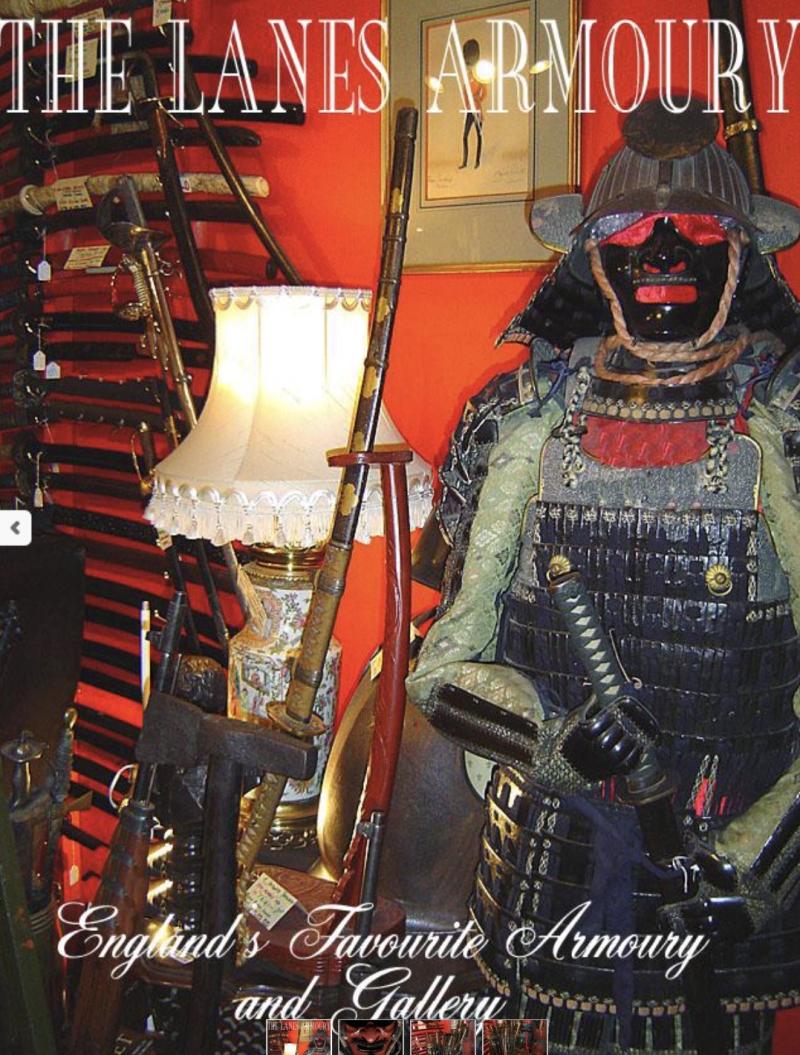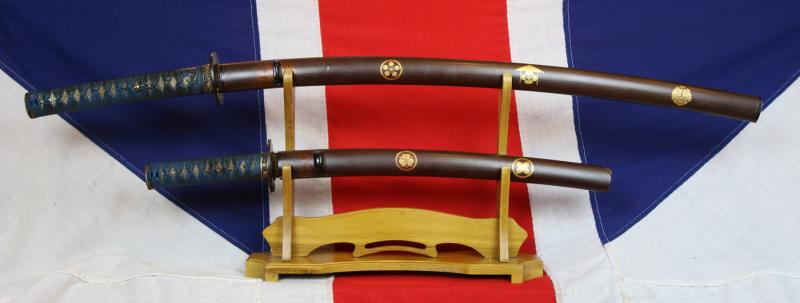Some Fantastic & Superb Pieces Just Arrived & Shall Be Added Soon. Including A Stunning Kunitake Early Shinto Katana With Kagonami Tsuba , & A Fine Kugyō Daisho, A Daito & Shoto, Some Of The Most Beautiful Samurai Swords We Have Seen
Just one of the beautiful aspects of the Kunitake 国武 katana is its beautiful blade with a captivating hamon, in beautiful polish. All its stunning fittings are original early Edo including the original urushi lacquer saya with an irridescent green ground of crushed abilone shell decor. Kabuto gane kashira, and its Kiyou-Tojin Nanban Tsuba, a large rectangular sword guard.
It is tettsu {iron} with gold wire inlay. The manner of execution of the tsuba represents a high degree of artistic hybridity, suggesting that the tsuba was made along maritime trade-routes, where artisans had access to decorative arts from around the globe. The indented corners, pointed Shitogi-gata seppa-dai, smooth-skinned dragons and almost caricature drawing- style points to Indochina, perhaps Tonkin. There is a similar piece in the 1973 W.M. Hawley book Tsubas (sic) in Southern California. One can see a number of similar pieces with NBTHK attribution to "Nagasaki". Although some believe it more likely is that these were imported to Japan through the VOC factory in Deshima.
Cultural exchanges between China and Nagasaki became quite frequent after the Kangxi emperor reopened Qing seaports to foreign trade in 1684, and issued trading licenses to private concerns.In the 1640s a number of refugees from the collapse of the Ming Dynasty emigrated to Nagasaki. One of them—Shoyu Itsunen became the abbot of Kofukuji temple in Nagasaki. Itsunen is also known to have taught painting to Kawamura Fukuyoshi, a samurai and customs official who is better known as Jakushi I. Another Chinese priest, Yinyuan Lonqi, was the abbot of Wanfu temple on Mount Huangbo in Fujian. He came to Nagasaki at the invitation of Itsunen. Lonqi, known in Japan as Ingen Ryuki, became the founder of Obaku Zen Buddhism. The Nagasaki school of painting was deeply influenced by the Chinese painter Shen Nanpin, who lived and taught painting in Nagasaki for several years. Nanpin’s work was heavily influenced by European scientific and botanical painting, which resonated with the intellectual community at Nagasaki, which in Japan was the centre of Chinese medical studies, and Rangaku (the study of European science).
Swordsmith; KUNITAKE (国武), Kan ́ei (寛永, 1624-1644), Yamashiro – “Heianjō-jū Fujiwara Kunitake” (平安城住藤原国武), “Kunitake” (国武), “Sanjō Kunitake” (三条国武), student of Horikawa Kunihiro (堀川国広), later smith from the line of Sanjō Yoshinori (三条吉則), a tradition says that he was the father of Izumo no Daijō Yoshitake (出雲大掾吉武), itame-nagare with ji-nie, suguha, notare mixed with gunome-ashi in ko-nie-deki, sugu-bōshi with a ko-maru-kaeri, wazamono, Rated as jō-saku {superior smith}
Nanban-style tsubas (Japanese sword guards) often feature intricate designs incorporating dragons and phoenixes. These designs, commonly found in Hizen ware during the Edo period, represent the harmonious union of opposites – the masculine dragon and the feminine phoenix. This symbolic representation reflects the balance between power and grace, often associated with the Emperor and Empress in Japanese culture.
Key aspects of Nanban tsubas with dragon and phoenix:
Symbolism:
The dragon represents strength and power, while the phoenix embodies grace and beauty. Together, they symbolize the harmonious union of opposites.
Design:
Nanban tsubas often feature intricate designs with dragons, phoenixes, and other floral motifs, sometimes incorporating techniques like pierced work, inlays, and gilding.
Influence:
Nanban style was influenced by foreign art and culture, particularly Chinese designs, which contributed to the prevalence of dragons and phoenixes in these tsubas.
Examples:
The Ashmolean Museum has examples of Nanban tsubas with these designs.
Nanban tsubas are typically made of iron and often feature intricate details in gold or silver.
During the 18th and 19th centuries, improved tools led to more delicate and rapid production of Nanban tsubas.
The daisho, that require at present professional conservation that shall be attended to, have finest original Edo saya, of urushi lacquer decorated with kamon of multiple clans, this suggests affiliations and allegiance to such clans, they are multiples of mon applied, on a ground of gold-nashiji, of gold-ikakeji. This form of highest superior work was restricted, in feudal times, to san mi 三位, samurai owners, of the third court-rank, or possibly even higher, such as 一位, Ichii, First rank, or, 二位, Nii, second rank. These samurai nobles of the third to higher ranks were called kugyō when these two swords was made and carried in the early Edo period of the Tokugawa shogunate.
First Rank (一位, Ichii): The highest court rank, reserved for individuals of exceptional merit and influence.
Second Rank (二位, Nii): A higher rank, often associated with those in positions of authority.
Third Rank (三位, Sanmi) and Fourth Rank (四位, Shii): These ranks denoted important positions in the court system
In feudal Japan, court ranks, known as mibun, were a hierarchical system defining the status and duties of individuals, particularly within the samurai class. These ranks influenced everything from a samurai's attire and position to their ability to request audiences with the Shogun. The system was a complex tapestry of colors, symbols, and titles, signifying one's place in the social order.
In the Tokugawa shogunate each of the First to Third Ranks is divided into Senior (正, shō) and Junior (従, ju). The Senior First Rank (正一位, shō ichi-i) is the highest in the rank system. It is conferred mainly on a very limited number of persons recognized by the Imperial Court as most loyal to the nation during that era.
The Junior First Rank (従一位, ju ichi-i) is the second highest rank, conferred in many cases on the highest ministers, premier feudal lords, and their wives.
Nobles with the Third Rank or upper were called kugyō.
Successive Tokugawa shoguns held the highest or near-highest court ranks, higher than most court nobles. They were made Shō ni-i (正二位, Senior Second Rank) of court rank upon assuming office, then Ju ichi-i (従一位, Junior First Rank), and the highest rank of Shō ichi-i (正一位, Senior First Rank) was conferred upon them upon their death. The Tokugawa shogunate established that the court ranks granted to daimyo by the imperial court were based on the recommendation of the Tokugawa shogunate, and the court ranks were used to control the daimyo.
Oda Nobunaga and Toyotomi Hideyoshi were Shō ni-i (正二位, Senior Second Rank) and Ju ichi-i (従一位, Junior First Rank) respectively, but both were elevated to Shō ichi-i (正一位, Senior First Rank) in the Taisho era, about 300 years after their deaths.
The daisho, prior to a ‘no expense spared’ conservation, cleaning and polishing, are shown in the gallery ‘as is’ now.
Code: 25784
Price
on
Request




